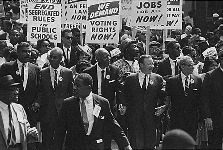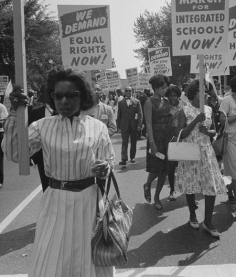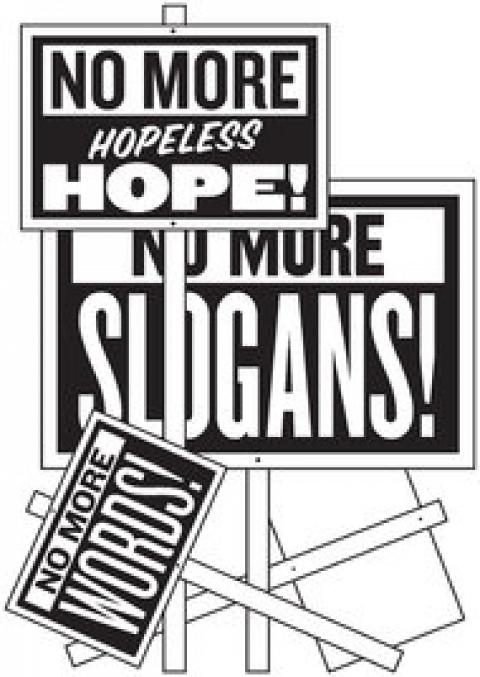On Aug. 28, 1963, nearly a quarter of a million people thronged the nation's capital for the March on Washington for Jobs and Freedom, the largest civil rights demonstration in American history. Its impact on American politics was tremendous: in addition to building support to pass the civil rights bill that President John F. Kennedy had recently proposed, marchers succeeded in strengthening and expanding the scope of the bill far beyond what the president had envisioned.
For many, the most important addition was Title VII, which prohibited employers and unions from discriminating on the basis of race, color, religion, national origin and sex. The ban on sex discrimination was itself a further amendment, introduced in January 1964 by Southern Democrats who hoped it would impede the bill's progress through Congress. Their plan backfired: not only did they fail to scuttle the bill, but their amendment also provided a critical legal tool in the fight for women's equality.
The message of the march still resonated in 1965, when Congress passed the Voting Rights Act, Medicare and Medicaid, key features of President Lyndon B. Johnson's proposal to bring "an end to poverty and racial injustice."
The march was so successful that we often forget that it occurred in a political environment not so different from our own. Kennedy's victory over Richard M. Nixon in 1960 signaled a break from the conservatism of the 1950s. But like the election of Barack Obama in 2008, hope for a return to the liberalism of the 1930s was dampened by an administration that rejected "old slogans" like wage increases and public works in favor of tax cuts and free trade to stimulate growth.
That disillusionment gave rise to sit-ins and freedom rides against segregation in the South, but those protests proved powerless in the face of entrenched conservative power. In contrast, the grass-roots movements that gained political influence in the Kennedy years were White Citizens Councils, the John Birch Society and other forces that, much like today's Tea Party movement, shifted the political spectrum to the right.
Given those obstacles, how did the March on Washington help drive support for such sweeping civil rights and domestic policy measures?
First, it linked the protest movements of the 1960s to institutions with longstanding roots in working-class communities. The initial call for the 1963 demonstration came from the Negro American Labor Council, an organization of black trade unionists that used local networks to plan for the march months before it was officially announced.
The Southern Christian Leadership Conference and the Student Nonviolent Coordinating Committee played similar roles in the South, mobilizing local civil rights groups, black churches and students. Support also came from the National Council of Negro Women and other elements of the black women's movement that had battled poverty and discrimination since the 19th century.
At the same time, organizers rallied supporters around a broad and ambitious set of demands. A. Philip Randolph, the veteran trade unionist who had first called for a march on Washington to protest employment discrimination in 1941, wanted the demonstration to focus on the shortcomings of Kennedy's economic policies. Pointing out that black workers were restricted to entry-level jobs that were most vulnerable to the automation and offshoring of manufacturing under way in the 1960s, he warned that without measures to end discrimination and create more jobs, blacks would be condemned to struggling for survival "within the grey shadows of a hopeless hope."

Other black leaders shared that concern, but some worried that a "march for jobs" would compete with the movement that the Rev. Dr. Martin Luther King Jr. and others were leading against legalized discrimination and disfranchisement. Anna Arnold Hedgeman, a prominent leader of the black women's movement, persuaded the men to plan a demonstration that would address "both the economic problems and civil rights."
Finally, while Randolph, King, Hedgeman and others expanded the mobilization to include a broad and multiracial coalition, they resisted pressure to moderate their tactics or demands.
Both black and white liberals worried that an angry protest would turn moderates in Congress against Kennedy's civil rights bill, but Randolph and King convinced the leaders of the N.A.A.C.P., the United Auto Workers and the National Urban League that the demonstration would be peaceful and effective.
It was the combination of these stalwart positions and rich institutional networks with the sheer number of peaceful black and white marchers that persuaded so many Americans of the rightness of civil rights and antipoverty legislation.
As we celebrate the 50th anniversary of the march, however, its central achievements are more imperiled than ever. This summer the Supreme Court upheld the principles behind the Civil Rights Act and the Voting Rights Act while severely weakening authority to enforce them. We have a charismatic liberal president and inspiring protest movements dedicated to racial equality and economic justice - but, as in the Kennedy years, they have proved no match for well-organized conservatives.

The solution may not be another march on Washington. But real changes in policy, and the defense of previous victories, require the combination of institutional backing, coalition building and ambitious demands that brought so many people to the National Mall in 1963.
[William P. Jones is a professor of history at the University of Wisconsin and the author of "The March on Washington: Jobs, Freedom and the Forgotten History of Civil Rights."]
A version of this op-ed appears in print on August 28, 2013, on page A27 of the New York edition with the headline: What Happened to Jobs and Justice?.


Spread the word